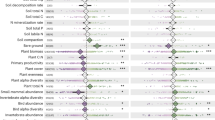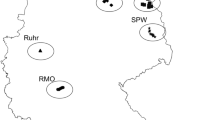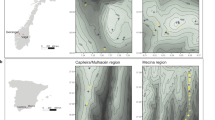Abstract
Predicting the impacts of present global warming requires an understanding of the factors controlling plant biomass and production. The extent to which they are controlled by bottom-up drivers such as climate, nutrient and water availability, and by top-down drivers such as herbivory and diseases in terrestrial systems is still under debate1. By annually recording plant biomass and community composition in grazed control plots and in herbivore-free exclosures, at 12 sites in a subArctic ecosystem, we were able to show that the regular interannual density fluctuations of voles and lemmings drive synchronous interannual fluctuations in the biomass of field-layer vegetation. Plant biomass in the field layer was between 12 and 24% lower the year after a vole peak than the year before, and the combined vole and lemming peaks are visible as a reduced normalized difference vegetation index in satellite images over a 770 km2 area in the following year, despite the wide range of abiotic, biotic and anthropogenic forces that influence the vegetation2,3,4,5. This strongly suggests that the cascading effect of rodents for the function and diversity of tundra plant communities needs to be included in our scenarios of how these ecosystems will respond to environmental changes.
This is a preview of subscription content, access via your institution
Access options
Subscribe to this journal
Receive 12 print issues and online access
$209.00 per year
only $17.42 per issue
Buy this article
- Purchase on Springer Link
- Instant access to full article PDF
Prices may be subject to local taxes which are calculated during checkout



Similar content being viewed by others
References
Terborgh, J., Holt, R. D. & Estes, J. A. in Trophic Cascades: Predators, Prey and the Changing Dynamics of Nature (eds Terborgh, J. & Estes, J. A.) Ch. 1, 1–18 (Island, 2010).
Bokhorst, S. F. et al. Winter warming events damage sub-Arctic vegetation: Consistent evidence from an experimental manipulation and a natural event. J. Ecol. 97, 1408–1415 (2009).
Post, E. & Pedersen, C. Opposing plant community responses to warming with and without herbivores. Proc. Natl Acad. Sci. USA 105, 12353–12358 (2008).
Walker, M. D. et al. Plant community responses to experimental warming across the tundra biome. Proc. Natl Acad. Sci. USA 103, 1342–1346 (2006).
Babst, F., Esper, J. & Parlow, E. Landsat TM/ETM plus and tree-ring based assessment of spatiotemporal patterns of the autumnal moth (Epirrita autumnata) in northernmost Fennoscandia. Remote Sens. Environ. 114, 637–646 (2010).
Post, E. et al. Ecological dynamics across the Arctic associated with recent climate change. Science 325, 1355–1358 (2009).
Shaver, G. R. et al. Species composition interacts with fertilizer to control long-term change in tundra productivity. Ecology 82, 3163–3181 (2001).
Aunapuu, M. et al. Spatial patterns and dynamic responses of arctic food webs corroborate the exploitation ecosystem hypothesis (EEH). Am. Nat. 171, 249–262 (2008).
Van Bogaert, R. et al. A century of tree line changes in sub-Arctic Sweden show local and regional variability and only minor role of 20th century climate warming. J. Biogeogr. 38, 907–921 (2011).
Johnson, D. R. et al. Exclusion of brown lemmings reduces vascular plant cover and biomass in Arctic costal tundra: Resampling of a 50+ year herbivore exclosure experiment near Barrow, Alaska. Environ. Res. Lett. 6, 045507 (2011).
Ericson, L. The influence of voles and lemmings on the vegetation in a coniferous forest during a 4-year period in northern Sweden. Wahlenbergia 4, 1–114 (1977).
Emanuelsson, U. Ecological Effects of Grazing and Trampling on Mountain Vegetation in Northern Sweden PhD thesis, Lund Univ. (1985).
Olofsson, J., Hulme, P. E., Oksanen, L. & Suominen, O. Importance of large and small mammalian herbivores for the plant community structure in the forest–tundra ecotone. Oikos 106, 324–334 (2004).
Kalela, O. Seasonal change of the habitat in the Norwegian lemming, Lemmus lemmus. Ann. Acad. Sci. Fenn. 55, 1–72 (1961).
Turchin, P. & Batzli, G. O. Availability of food and the population dynamics of arvicoline rodents. Ecology 82, 1521–1534 (2001).
Tikhomirov, B. A. Relationship of the Animal World and the Plant Cover of the Tundra (Russian Academy of Science, 1951).
Moen, J., Lundberg, P. A. & Oksanen, L. Lemming grazing on snowbed vegetation during a population peak, northern Norway. Arctic Alpine Res. 25, 130–135 (1993).
Ims, R. A., Henden, J. A. & Killengreen, S. T. Collapsing population cycles. Trends Ecol. Evol. 23, 79–86 (2008).
Kausrud, K. K. et al. Linking climate change to lemming cycles. Nature 456, 93–98 (2008).
Dahlgren, J. et al. Plant defenses to no avail? Responses of plants of varying edibility to food web manipulations in a low arctic scrubland. Evol. Ecol. Res. 11, 1189–1203 (2008).
Tast, J. & Kalela, O. Comparisons between rodent cycles and plant production in Finnish Lapland. Ann. Acad. Fenn. A, IV Biologica 186, 1–14 (1971).
Laine, K. & Henttonen, H. The role of plant production in microtine cycles in northern Fennoscandia. Oikos 40, 407–418 (1983).
Jepsen, J. U. et al. Monitoring the spatio-temporal dynamics of geometrid moth outbreaks in birch forest using MODIS–NDVI data. Remote Sens. Environ. 113, 1939–1947 (2009).
Olofsson, J., Ericson, L., Torp, M., Stark, S. & Baxter, R. Carbon balance of Arctic tundra increased snow cover mediated by a plant pathogen. Nature Clim. Change 1, 220–223 (2011).
Olofsson, J. et al. Herbivores inhibit climate-driven shrub expansion on the tundra. Glob. Change Biol. 11, 1205–1216 (2009).
Walker, D. A. et al. Spatial and temporal patterns of greenness on the Yamal Peninsula, Russia: Interactions of ecological and social factors affecting the Arctic normalized difference vegetation index. Environ. Res. Lett. 4, 1–16 (2009).
Van Wijk, M. T. & Williams, M. Optical instruments for measuring leaf area index in low vegetation: Application in arctic ecosystems. Ecol. Appl. 15, 1462–1470 (2005).
Bhatt, U. S. et al. Circumpolar Arctic tundra vegetation change is linked to sea ice decline. Earth Interact. 14, 1–20 (2010).
Acknowledgements
The authors are grateful to staff at Abisko Scientific Research Station for their assistance in making this study possible. We thank L. Oksanen for discussions. The work was financially supported by the Nordic Centre of Excellence—Tundra, the European Commission (ENV4-CT97-0586), the Swedish Research Council for Environment, Agricultural Science and Spatial Planning to J.O. (2006-1539) and T.V.C. (214-2008-188 and 214-2009-389) and the Research Council of Norway to H.T. (216434/E10).
Author information
Authors and Affiliations
Contributions
J.O. managed the long-term herbivore exclosure experiment and carried out plant measurements in the field. H.T. carried out the image processing and the NDVI estimations from satellite images. J.O. carried out the statistical analyses and wrote the manuscript, to which all authors contributed with discussions and text.
Corresponding author
Ethics declarations
Competing interests
The authors declare no competing financial interests.
Supplementary information
Rights and permissions
About this article
Cite this article
Olofsson, J., Tømmervik, H. & Callaghan, T. Vole and lemming activity observed from space. Nature Clim Change 2, 880–883 (2012). https://doi.org/10.1038/nclimate1537
Received:
Accepted:
Published:
Issue Date:
DOI: https://doi.org/10.1038/nclimate1537
This article is cited by
-
Detection of spatial avoidance between sousliks and moles by combining field observations, remote sensing and deep learning techniques
Scientific Reports (2022)
-
Tundra vegetation change and impacts on permafrost
Nature Reviews Earth & Environment (2022)
-
UAV reveals substantial but heterogeneous effects of herbivores on Arctic vegetation
Scientific Reports (2021)
-
High Arctic ecosystem states: Conceptual models of vegetation change to guide long-term monitoring and research
Ambio (2020)
-
Herbivore Effects on Ecosystem Process Rates in a Low-Productive System
Ecosystems (2019)



